Exploring the World of Virtual Reality Slots


Intro
In recent years, the intersection of gaming and technology has given rise to an immersive experience that transcends traditional entertainment. Virtual reality slots epitomize this evolution, providing players with an experience that is not simply about spinning reels but offers a vivid world where the casino atmosphere leaps out of the screen. As the landscape of online gambling continues to shift dramatically, understanding these advancements becomes imperative for enthusiasts and developers alike.
What makes VR slots truly stand out is their unique mechanics. Unlike ordinary online slots, which primarily rely on visual and auditory stimuli, VR slots engage players through fully three-dimensional environments, offering a sense of physical presence that traditional games can only aspire to. This quite literally changes the game; players find themselves standing within the virtual casino, interacting with elements in ways that feel almost tangible.
In this exploration, we shall delve into several core aspects of VR slots. First, we will unpack the technology that drives these experiences, shedding light on the innovations that have enabled such depth in gameplay. Following this, we'll look at design elements that enhance immersion and complicate strategies for gameplay. Of course, we cannot overlook the psychological components that draw players in and keep them engaged.
Beyond these discussions, we will also look into practical strategies for both players looking to enhance their play and developers aiming to create the next big hit in VR gaming. By navigating through these themes, readers can expect to glean valuable insights about how VR slots are redefining the online gambling industry and what future prospects might hold.
As we move forward, it’s essential to recognize the importance of both strategy and technology in the realm of VR slots. With this comprehensive guide, we hope to furnish our readers—whether they be gamblers, marketers, or analysts—with the tools and understandings they need to succeed in this vibrant new frontier.
Prelude to VR Slots
In recent years, virtual reality (VR) technology has transformed numerous fields, and online gambling is no exception. As gamblers increasingly seek more immersive experiences, VR slots have emerged as a prominent player, promising a unique blend of technology and play. Understanding the significance of VR slots is essential, not only for players looking for fresh thrills but also for developers aiming to innovate in the gaming market.
The core attraction of VR slots lies in their ability to create an engaging atmosphere, offering users a real sense of presence in a vibrant virtual casino environment. Unlike traditional slot games that remain somewhat flat, VR slots immerse players in a three-dimensional space where they can interact with the game more tangibly—imagine spinning the reels while seated at a dazzling virtual table, surrounded by other players and beautiful graphics.
Benefits of VR Slots:
- Enhanced Engagement: The realism of VR contributes to deeper focus, leading to longer play sessions. Players often feel as if they are part of the action—blurring the lines between the real and the virtual.
- Social Interaction: Many VR slots incorporate multiplayer aspects, allowing friends to join in on the fun, even if they are miles apart. This social component adds an exciting dimension that traditional slots often lack.
- Innovative Gameplay Mechanics: VR slots can introduce complexities and features not feasible in standard formats. From interactive bonus rounds to unique themes and storylines, these games provide refreshing content that appeals to a wide audience.
However, it's not all smooth sailing. Several considerations come into play:
- Hardware Requirements: Players need specific VR equipment, which can be a hurdle for some potential users.
- User Experience Design: The transition to VR demands a rethinking of the user interface—what works on a 2D screen may not translate well into a 3D space.
- Accessibility and Inclusivity: While VR can enhance the experience, it can also alienate individuals who lack the necessary technology or face difficulties interacting with VR systems.
As the gambling landscape evolves, grasping the role of VR slots is vital for navigating the future of online gaming. For enthusiasts eager to explore this innovative frontier, understanding the nuances of VR slots is the first step into a world that promises not just games, but experiences.
“The future of any industry is rooted in its ability to adapt—VR slots are not just a trend; they're a revolution in online gambling.”
To dive deeper into this topic, players and developers alike can benefit by exploring reputable resources such as Wikipedia on Virtual Reality and relevant discussions on platforms like Reddit. As this technology continues to mature, the interplay of VR and slots beckons us to look ahead and embrace the possibilities.
The Evolution of Slot Games
The journey of slot games is quite akin to a captivating tale woven through time, demonstrating the resilience and adaptability of the gaming industry. Understanding this evolution is paramount, as it sheds light on how the traditional penny slot has transformed into the immersive playground of virtual reality. This section will unpack the metamorphosis of slot machines, tracing back from their mechanical roots to the advanced technology we see today, like VR.
From Mechanical to Digital
In the late 19th century, slots emerged as simple, mechanical devices using spinning reels and a lever. The very first slot machine, the Liberty Bell created by Charles Fey in 1895, established the basic principles of slot gaming. Players would pull the lever to set the reels in motion, and a combination of symbols would determine the outcome. This was a breakthrough but limited to physical locations.
As technology advanced, these mechanical contraptions gave way to their electronic counterparts in the 1960s. Electronic slots, first appearing in Las Vegas casinos, incorporated lights and sounds that elevated player engagement. With the introduction of random number generators (RNGs) in the 1980s, these games were no longer just about luck and manual mechanics; now players saw a surge in fairness and unpredictability.
Prelude of Online Slots
The real game changer came in the late 1990s with the rise of the internet. Online casinos popped up like wildflowers, and soon, the classic experience was available on countless devices. HTML, combined with other programming languages, allowed for more complex gameplay mechanics and enhanced graphics. The digital age could not be ignored—players worldwide had access to hundreds of games from the comfort of their homes.
These online slots offered the same thrill, with features like free spins, multipliers, and bonus rounds that traditional slots simply couldn't compete with. It was an avalanche of opportunities—players could sit back, relax, and throw a few virtual coins into the digital slots without ever leaving their couches, breaking geographical barriers.
Transition to Virtual Reality
Now, as if the evolution was not enough, we reached a dramatic pivot point: virtual reality slots. Designed to pull players into an entirely three-dimensional casino, VR technology creates an immersive experience that transports players from their living rooms into vibrant gaming worlds. Unlike the earlier versions, VR slots integrate not just sights and sounds, but an entire environment that responds to a player's actions.
Players can interact with the game as if they are physically present, grabbing coins or pulling levers. The sense of presence can be incredibly powerful, encouraging longer play sessions and deeper engagement.
The rise of VR is a response to an increasingly sophisticated audience that's hungry for richer experiences. Traditional gameplay feels like a flat canvas compared to the vivid masterpieces emerging with virtual reality.
The transition to VR doesn't just enhance gameplay but redefines what gamblers can expect. With each spin, players don't just chase payouts, they also embark on a journey through visually stunning landscapes populated with characters and themes that draw them deeper into the gaming experience.
As we delve deeper into VR slots, it's crucial to acknowledge the groundwork laid by their predecessors. The evolution we have traced here illustrates the industry's innovation and promises an exciting future that continually melds technology with the thrill of gaming.
Understanding VR Technology
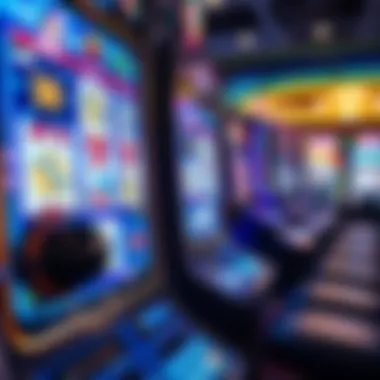
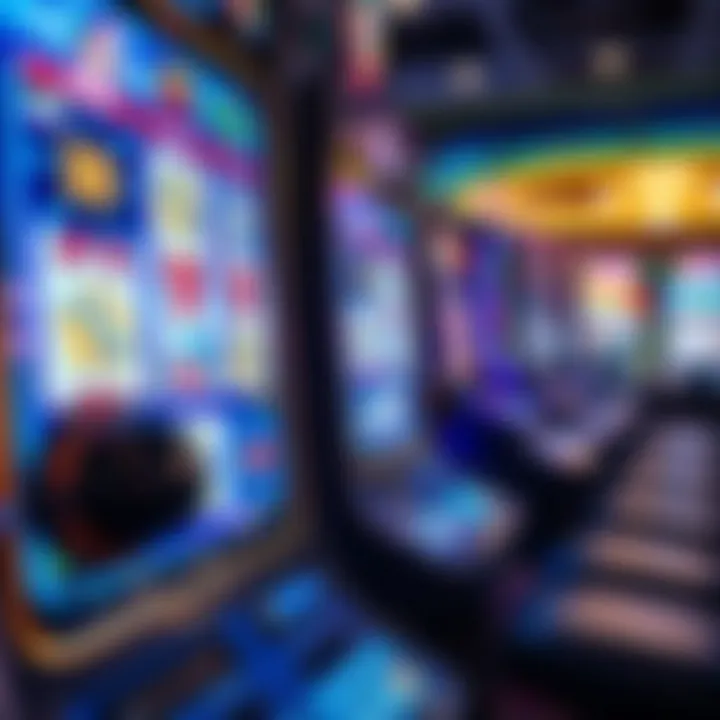
Understanding the realm of VR technology is pivotal for grasping how virtual reality slots are transforming the landscape of gambling. This section sheds light on the specific components and software behind VR systems, offering insight into how they create immersive experiences that are markedly different from traditional slot games.
Components of VR Systems
To really get a handle on what makes VR slots tick, it’s essential to dive into the components of VR systems. These components fall broadly into hardware and software categories, both playing vital roles in the user experience.
- Head-Mounted Displays (HMDs): These devices, like the Oculus Rift and HTC Vive, create the virtual environment. A good HMD will have a high resolution, wide field of view, and refresh rate to minimize motion sickness and enhance immersion.
- Controllers: Controllers allow players to interact with the virtual environment. For VR slots, these often function as virtual hands, enabling players to press buttons or pull levers, making it feel like they’re truly in a casino.
- Tracking Systems: These systems track the movement of the player’s head and body, translating real-world actions into the virtual space. Commonly, these are achieved through positional sensors, offering an engaging experience where every head movement feels natural.
- Audio Systems: Sound is a key element in immersion. High-quality 3D spatial audio systems enhance the experience by placing sounds in the virtual environment, guiding the player’s attention to crucial game elements.
Each of these components must work in harmony to provide an experience that feels as real as possible, and that’s what draws many players into the ever-expanding universe of VR slots.
Software Requirements
Getting the hardware right is only half the battle; software forms the backbone of the VR experience. Several requirements need to be met to ensure smooth gameplay and vivid imagery.
- Game Engine Compatibility: Software such as Unity or Unreal Engine is frequently utilized for VR game development. These engines create rich visuals and complex gameplay mechanics specific to VR environments.
- Drivers and Middleware: Proper drivers for HMDs and hand controllers are essential. Middleware such as SteamVR acts as an intermediary, bridging various hardware with game engines.
- High-Performance Graphics: Games require robust graphics processing capabilities. A VR slot game must run at high frame rates with minimal lag; any stuttering can be detrimental to the immersive experience.
- User Interface Design: Special considerations must be made for the HUD in VR environments. Designers must craft interfaces that are intuitive and easy to navigate without taking players out of the immersion.
In constructing compelling VR slot games, these software requirements are non-negotiable. They directly impact the gameplay experience and player satisfaction.
"The level of detail and precision in VR technology can turn a simple slot game into a full-fledged experience, transporting players from their living rooms to vibrant casinos around the world."
Both components and software are integral to understanding the full impact of VR technology on slots. As this technology continues to improve, so too will the experiences player encounter, which leads to mpre engaging and thrilling gameplay in the future.
Design Elements of VR Slots
Understanding the design elements of VR slots is crucial for creating an immersive and engaging user experience. These elements not only seal the deal with visual appeal but also play a significant role in user interactivity and retention. With the demand for more engaging online gaming experiences, VR slots need thoughtful integration of graphics, sound, and user interface to captivate a diverse audience. Here, we will unpack three vital components: visual aesthetics, audio effects, and user interface considerations, all of which must effectively come together to elevate the player's experience.
Visual Aesthetics
Visual aesthetics in VR slots are all about making a first impression that sticks. The graphics need to pop, enveloping players in a world designed to attract and keep their attention. Unlike traditional slots, where the visuals might take a backseat, VR slots have the advantage of a 360-degree field of view. This allows for designs that can surround players with lush landscapes, themed environments, and high-quality animations. For instance, a pirate-themed slot can combine vibrant ocean backdrops with detailed ship designs, making players feel as if they’ve set sail on a grand treasure hunt.
Key components of visual aesthetics include:
- Color Palette: Properly chosen colors can invoke emotions and heighten excitement. Bright colors often lead to feelings of joy, while deeper shades can create suspense.
- Animation Quality: Smooth animations enhance the gameplay and give life to the slot. Characters or symbols that animate convincingly can captivate the attention of players and encourage longer play.
- Theme Cohesion: Themes should be cohesive throughout the entire experience—from the graphics to specific symbols, each element needs to relate back to the overall concept, making it easier for players to connect.
Implementing these visual elements carefully can significantly boost player satisfaction and retention.
Audio Effects and Immersion
Sound can very much make or break the gaming experience, especially in a VR environment. With the right audio effects, players can find themselves deeply engrossed in the action. Sounds can enhance the realism of the gaming environment, block out distractions, and create emotions that keep players wanting more.
Considerations for audio effects include:
- Ambient Sounds: These subtle audio cues, like birds chirping or waves crashing, can create a realistic backdrop, placing players in the setting of the game.
- Win Sounds: Auditory feedback when players win adds to the excitement and thrill. For instance, a crescendo of sounds can add to the elation of landing a winning combination.
- Interactive Sounds: These are the sounds that relate closely to the player’s actions, such as spinning the reels or triggering bonus features. These sounds should feel rewarding and provide player feedback.
Effective integration of audio elements can enhance immersion to levels where players truly feel part of the game.
User Interface Considerations
An intuitive and efficient user interface is the backbone of any successful VR slot. It's crucial that players can navigate the game with ease, especially when they are potentially wearing VR headsets that can limit visibility and hand interaction. Simplicity paired with effective design can lead to a smoother gameplay experience.
Essential considerations for crafting user interfaces in VR slots encompass:
- Accessibility: Elements must be large enough to interact with and easy to locate. Using symbols or visual indicators can be more accessible than text, which can be hard to read in VR.
- Layout Design: Menus and buttons should be easily distinguishable and should allow for seamless transitions between different game elements, such as bonus rounds and settings.
- Responsive Feedback: Players should receive feedback when they interact with different elements. This could range from subtle vibrations to visual changes that acknowledge the player’s action.
By focusing on these user interface elements, developers can not only increase player satisfaction but also foster a more engaging and user-friendly environment.
The design of VR slots is not just about looks; it's about creating a multi-layered experience that caters to the senses, captures the imagination, and, ultimately, keeps players coming back for more. For further exploration into effective design elements, resources like Wikipedia and articles on Britannica may offer deeper insights into game design principles.
Game Mechanics in VR Slots
Understanding game mechanics in virtual reality slots is crucial for both developers and players. These mechanics dictate how players interact with the game, influence the overall experience, and ultimately determine the success of the VR slot in an ever-competitive market. Unlike traditional slot games, where players simply watch as reels spin, VR slots create an environment that encourages active participation.
Gameplay Dynamics
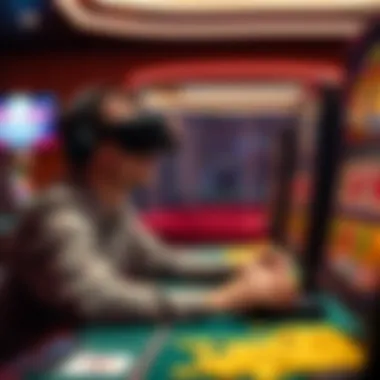
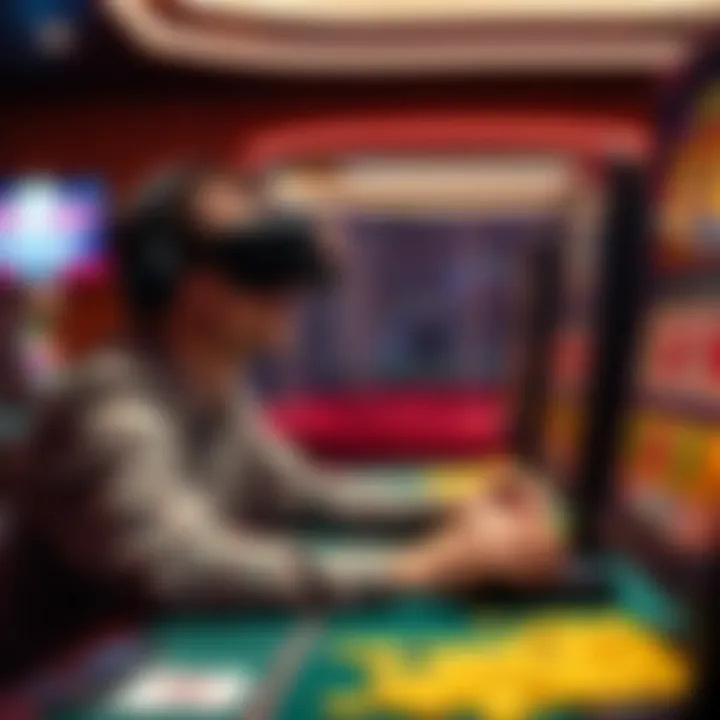
In VR slots, gameplay dynamics are all about how players engage within the virtual space. Immersion plays a pivotal role here, transforming a once-voyeuristic experience into an interactive adventure. Players are no longer limited by a flat screen; rather, they step into a 3D environment where they can manipulate their surroundings.
For instance, in a VR slot game set in a mystical forest, players might be able to reach out and pull a lever in a realistic manner, or even select symbols by pointing and clicking with their VR controllers. This blend of physical interaction with visual elements creates a stimulation that can’t be matched by traditional online slots. Not to mention, the excitement of a winning spin feels amplified in a three-dimensional space, making the gameplay not just enjoyable, but also potentially addictive.
Paylines and Payouts
The concepts of paylines and payouts have evolved in the realm of VR slots. Traditional slots tend to stick to a fixed number of paylines, often resulting in static betting strategies. In contrast, VR slots can introduce dynamic paylines, allowing either the game or the player to adjust the number of active lines in real-time.
- Dynamic Paylines: Players might be able to activate or deactivate lines based on their gaming strategy or money management approach. This flexibility adds depth and strategy to the game.
- Winning Patterns: With 3D graphics, the winning patterns can appear more visually appealing, and the payouts can be animated in engaging ways, enhancing the exhilaration of a win.
- Customization Options: Some VR slot games even allow players to customize their paylines, selecting which symbols pay out more or less, which takes the personalization aspect a step further.
All these factors not only change how the game is played but also contribute to a unique user experience that sticks in players' minds long after they log off.
Bonus Features and Innovations
Bonus features are where the world of VR slots can truly shine. These features not only keep the gameplay engaging but also serve as a key incentive for players to keep spinning the reels. Traditional slots have bonus rounds like free spins or pick-and-win features, but VR slots can take this to a new level. Consider the following:
- Interactive Bonus Rounds: Imagine being transported into an underwater treasure hunt, where players physically dive to collect coins and treasures—this is the type of interactivity that VR can offer.
- Augmented Elements: Layering augmented elements into VR can also enhance bonus features. For instance, seeing specific symbols trigger real-time events in the environment could surprise and delight players.
- Social Features: Adding multiplayer elements where friends can join each other in a VR slot game makes the experience more community-oriented. This social aspect can lead to increased engagement as players share victories and experiences in real time.
"By leveraging these advanced game mechanics, developers can create a captivating environment that goes beyond mere entertainment, fostering a sense of adventure among players."
The innovation in bonus features not only enhances gameplay but effectively deepens the players' emotional connection to the game, pushing boundaries of what online slots can truly accomplish.
Understanding these game mechanics is essential for anyone venturing into the realm of VR slots—developers need to harness these elements to create captivating experiences, while players must grasp how these mechanics can enhance their enjoyment and potential returns.
Psychological Impact of VR Slots
When it comes to virtual reality (VR) slots, the psychological effects cannot be understated. Understanding how VR influences player behavior and mindset is crucial for both developers and players alike. VR's design does more than entertain; it taps into a player's emotions, perceptions, and even decision-making processes. The sense of immersion offered by VR slots creates a unique environment where players feel a deeper connection, not only to the game itself but to the broader gambling experience. The upcoming sections will delve into aspects that reveal how this technology reshapes our interaction with gaming.
Immersion and Engagement
Immersion in VR slots is a game-changer. This kind of interaction composes a 360-degree experience that traditional slots simply can't match. Players might feel as if they are actually sitting in a luxurious casino, surrounded by the sounds of coins, jingles, and cheers from other players. This heightened engagement means that players are more likely to lose track of time and money, as the line between reality and the game blurs.
The sense of presence—where users feel they are 'actually there' in that virtual space—contributes substantially to this immersion. Research shows that immersion can lead to increased emotional responses, which enhances the entire gambling experience. With specific designs, like dynamic backgrounds and realistic animations, developers aim to replicate this authentic feeling. Moreover, the community aspect can amplify that connection, with features that allow for multiplayer experiences, allowing users to connect and compete, or share in the excitement of jackpots.
"Complete immersion often results in players experiencing the game on a psychological level, blurring the lines between enjoyment and addiction."
Cognitive Responses to VR Gaming
Cognitive responses in VR gaming present another layer of complexity. The brain reacts differently when engaged in a VR environment. For example, players often display heightened arousal and engagement, leading to increased dopamine flow, the chemical associated with pleasure. Consequently, the thrill of spinning the reels becomes more intense, making the experience addictive for some.
However, there are also potential downsides that have been raised by psychologists and gaming experts. Players can develop unrealistic expectations or behaviors, ranging from chasing losses to a diminished sense of risk. It is essential for players to recognize these patterns and be aware of their gambling habits, particularly in a VR setting where reality and fantasy meld.
Some factors influencing cognitive responses include:
- Sensory Input: High-quality graphics and 3D sounds can lead to more cognitive engagement and emotional influence.
- Social Interaction: Multiplayer modes encourage socializing, which can either enhance one’s mood or increase the pressure to perform.
- Reward Systems: The design of rewards and bonuses can affect how players perceive their wins and losses.
Overall, as VR slots evolve, so do the insights into their psychological impact. Understanding these aspects is key to navigating this engaging, but often complex world.
Comparing Traditional and VR Slots
When observing the shifting landscape of online gambling, the comparison between traditional slot games and their virtual reality counterparts emerges as a crucial topic. Not only does this comparison highlight distinct differences in user experience, but it also delves into the larger implications for market trends and player preferences. Understanding these elements can aid gamblers, developers, and marketers alike as they navigate this rapidly evolving domain.
User Experience Differences
The user experience in traditional slot games and VR slots diverges in several significant ways. Traditionally, slots are stationary pursuits, where players engage by merely pressing buttons or pulling levers. Although the designs can vary, the interaction with these games often lacks a sense of physicality and immersion.
In contrast, VR slots transport players into a three-dimensional environment that simulates a real casino experience. This transition cultivates a more interactive and tangible connection. In a VR setting, players can leisurely wander through a virtual casino, interact with fellow gamers, and engage with machines that require more bodily movement, such as reaching out to pull a handle or pushing a button.
- Immersion: VR slots offer a higher level of immersion due to enhanced graphics and audio, transporting players into vibrant worlds filled with dynamic interactions.
- Sense of Presence: Players often feel a more pronounced sense of presence in VR. The sensation of being part of the game enhances enjoyment and engagement, setting a vibrant stage that traditional slots rarely achieve.
- Feedback Mechanisms: Haptic feedback integrated into VR slots can provide players with physical sensations corresponding to gameplay events, enriching the overall experience. This element is lacking in traditional formats, making VR a top contender.
Market Trends and Preferences
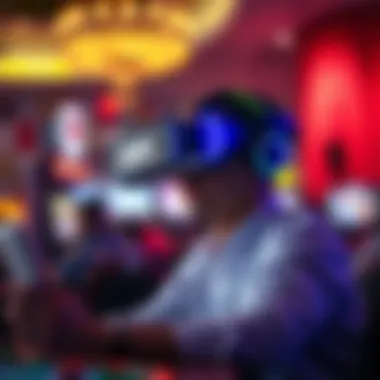
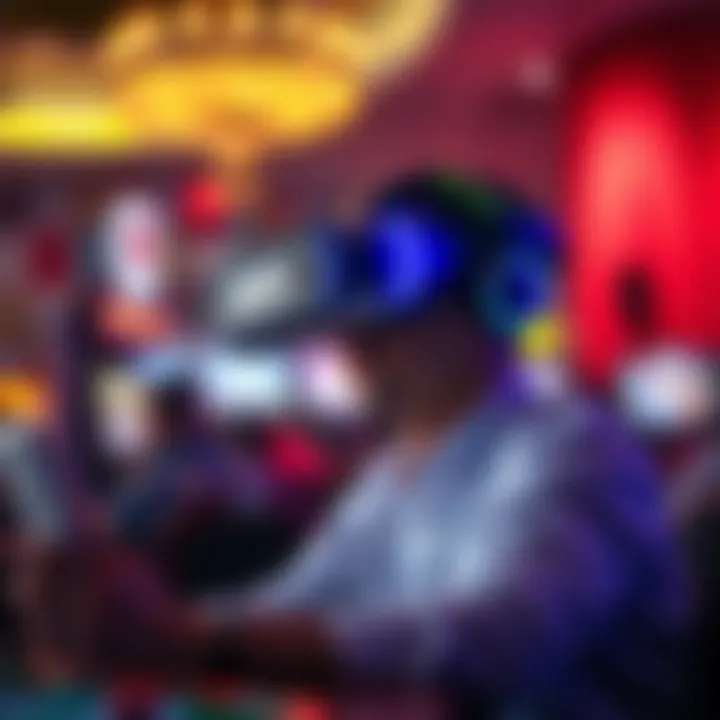
Examining current market trends reveals a growing preference towards immersive experiences. As technology has advanced, players are increasingly drawn to the standout features offered by VR slots. The surge in high-quality VR headsets and increasing accessibility via platforms like Oculus and PlayStation have contributed to this trend.
A few noteworthy trends include:
- Increased Player Engagement: Market research shows players are fascinated by the potential for longer session times due to the immersive nature of VR slots. With the growing number of gamers willing to explore, developers need to perceive this as an opportunity to create enticing VR-related content.
- Demographic Shifts: While traditional slots tend to attract an older audience, VR slots are captivating younger players who are more accustomed to digital interactions and advancements. This demographic shift is noteworthy for marketers as they strategize roles in promotion and audience targeting.
- Adaptation of Older Titles: Many traditional games are being reinvented as VR experiences, capturing nostalgia while enticing new players. This movement towards innovation showcases the adaptability of the gambling sector in embracing new technologies.
Regulations and Fair Play
In the rapidly evolving landscape of virtual reality slots, understanding the significance of regulations and fair play cannot be overstated. As players engage with immersive gaming experiences, ensuring a safe and fair environment is paramount for both user trust and industry sustainability. The unique nature of VR gaming introduces a slew of questions regarding compliance, ethical practices, and the safeguarding of player interests.
Gambling Laws and VR Slots
The legal framework surrounding gambling is complex and varies significantly from one jurisdiction to another. As VR slots continue to gain popularity, it’s essential to consider how existing gambling laws apply to this innovative format. There are several critical aspects to examine:
- Licensing: Operators of VR casinos often must secure licenses from relevant governing bodies. This process ensures that they adhere to specific standards of operation and consumer protection.
- Age Restrictions: Most jurisdictions have strict age limits on gambling activities. VR slot platforms must implement robust age verification mechanisms to prevent underage participation.
- Geographic Restrictions: Some regions impose outright bans on online gambling or VR gaming, which can impact potential users’ access to these slots.
Overall, keeping abreast of changing gambling laws is crucial for players, operators, and developers alike, as it shapes the availability and legality of VR slots.
Fairness and Transparency Considerations
When it comes to online gaming, fairness is a central pillar that builds player confidence and loyalty. VR slots are no exception, and several factors contribute to ensuring this fairness:
- Random Number Generators (RNGs): At the heart of fair play in slots is the RNG, which guarantees that outcomes are random and unpredictable. VR slot developers must utilize certified RNG technology to ensure integrity.
- Certification and Testing: Independent agencies often conduct testing and certification of gaming software to validate that games are fair and adhere to industry standards. This process helps maintain transparency and protects players from potential fraud.
- Player Options: Providing players with clear information regarding game mechanics, payout percentages, and bonus features enhances transparency. This access empowers users to make informed decisions while engaging in VR gaming.
By focusing on fairness and transparency, the VR slot industry can cultivate trust among players, encouraging more extensive participation and fostering a healthy gaming ecosystem.
"As the realm of VR slots grows, a commitment to regulations and fair play will be key in shaping its future and ensuring a safe playground for all players."
To explore further about gambling regulations and the importance of fair play, visit reputable resources like Wikipedia and Britannica. These platforms provide comprehensive insights into the legal framework driving gambling activities.
Future Prospects of VR Slots
The future of virtual reality slots holds substantial importance in the context of online gambling. As the gaming industry continues to evolve, understanding the potential of VR slots becomes crucial for stakeholders ranging from developers to players. With technology rapidly advancing, the possibilities for enhanced player engagement, creativity in game design, and the overall gaming experience appear limitless. This section explores two core aspects: technological advancements and market growth potential, offering insights that illuminate what could be on the horizon for VR slots.
Technological Advancements
In the realm of VR slots, technological advancements stand as a cornerstone for future progress. The improved capability of VR headsets, specifically through heightened graphics, visual acuity, and reduced latency, elevate player immersion to new heights. For example, devices such as the Meta Quest Pro or Valve Index offer stunning graphics and responsive tracking that allow players to fully engage with their games.
Additionally, developments in haptic feedback technology are making gameplay experiences even more tactile. Imagine spinning the reels and feeling the vibrations resonate through the controller or headset—this can deepen emotional investment and satisfaction. Furthermore, augmented reality (AR) may start blending with VR, providing players with environments that feel simultaneously fantastical yet grounded in reality. The fusion of these technologies could create experience that's not just about playing a game but truly living in a virtual casino environment.
Yet, the advancements don’t stop at hardware. Software improvements, such as more sophisticated AI algorithms, can enable games to learn player preferences and tailor experiences accordingly. This means a bespoke gaming experience where the slots feel more in tune with individual players, pushing engagement levels even higher. Innovations such as blockchain can also enhance security and transparency, providing confidence to users wary of online gambling's risks.
Market Growth Potential
The market growth potential for VR slots cannot be overstated. According to various industry reports, the global gaming industry is projected to reach billions in revenue within the next couple of years. For VR slots specifically, we’re likely to see exponential growth fueled by increasing adoption of VR gaming technologies.
The demographic landscape is also changing. Younger players, who are more inclined to embrace new technologies, represent a significant market segment for VR slots. As these players begin to enter the gambling space, VR slots could become a go-to option due to their immersive nature and engaging gameplay mechanics.
In addition, partnerships between gaming companies and VR hardware manufacturers are expected to yield innovative products tailored for the casino industry. These collaborations can lead to a richer array of experiences while also promoting cross-platform accessibility, allowing players to enjoy VR slots seamlessly across different devices.
Moreover, with regulatory frameworks slowly adapting to the rise of technology in gambling, the legal landscape appears more favorable for VR operators. Emerging laws that support innovative gaming technologies can boost investor confidence, leading to increased backing for VR slot development.
"The potential of VR slots is not merely a product of technological advancement; it is a reflection of changing player expectations and habits."
Epilogue
In summing up the complex world of VR slots, it becomes evident that this niche brings something exceptional to the gaming table. The crossover between traditional slot mechanics and cutting-edge virtual reality creates a fully immersive experience, unlike anything encountered before. This synthesis of technology and game-play allows players to not only engage with the content but also interact with it in ways that were previously unimaginable.
Importance of the Topic
Understanding the significance of VR slots is essential for several reasons:
- Enhanced User Experience: Players are looking for more than mere entertainment; they seek engagement and interaction. VR slots deliver this by placing users in a three-dimensional environment where they can explore, touch, and feel the game, leading to improved satisfaction.
- Psychological Benefits: The immersion experienced in VR can lead to a state of flow, an optimal experience where users lose track of time and are wholly absorbed in the game. This can create a powerful emotional connection to the game, increasing loyalty and encouraging repeat play.
- Future of Gaming: As technology continues to advance, VR is likely to become a standard in online gaming. Understanding how it works gives developers and players alike an edge in navigating what’s next.
Considerations for Players and Developers
For players, venturing into the world of VR slots opens up a treasure trove of experiences. The ability to engage with games on a deeper level could redefine their expectations, turning a simple spin of the reels into an adventure. On the other hand, developers must remain keenly aware of the challenges that accompany this emerging tech. Balancing innovative design with user accessibility is crucial. Providing options for different levels of VR expertise will be key to broadening player base and ensuring inclusivity.
Immersive experiences are not just the future; they are the present, redefining our approach to engagement in gaming and beyond.







